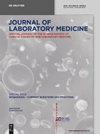c反应蛋白与白蛋白比值对重症肺炎患者28天死亡风险的预测价值
IF 1.1
4区 医学
Q4 MEDICAL LABORATORY TECHNOLOGY
引用次数: 0
摘要
目的探讨c反应蛋白(CRP)与白蛋白(ALB)比(CAR)对重症肺炎患者28天死亡风险的预测价值。方法选取2020年1月~ 2022年1月收治的重症肺炎患者152例,根据患者治疗28 d后的生存情况分为生存组(n=107)和死亡组(n=45)。比较两组患者的临床资料,采用多元logistic回归分析探讨28天死亡率的影响因素。绘制受试者工作特征(ROC)曲线,评估CAR对预测28天死亡风险的价值。建立了风险预测模型,并对其预测效率进行了评价。结果死亡组患者年龄、急性生理与慢性健康评估(APACHE)评分、Murray肺损伤评分、序贯性器官衰竭评分、白细胞计数、中性粒细胞计数、红细胞体积分布宽度、中性粒细胞/淋巴细胞比值(NLR)、纤维蛋白原、降钙素原、血乳酸(Lac)、CRP、CAR、氧合指数、ALB均显著低于生存组(p<0.05)。APACHE II评分、NLR、Lac和CAR是28天死亡率的独立危险因素(p<0.05)。建立的预测模型AUC为0.826,灵敏度为88.45 %,特异度为87.32 %,判别性高。当风险阈值概率为11-93 %时,nomogram模型具有临床应用价值。结论CAR是一个独立的危险因素,对重症肺炎患者28天死亡风险具有较高的预测价值。本文章由计算机程序翻译,如有差异,请以英文原文为准。
Predictive value of C-reactive protein-to-albumin ratio for risk of 28-day mortality in patients with severe pneumonia
Abstract Objectives To explore the predictive value of C-reactive protein (CRP)-to-albumin (ALB) ratio (CAR) for the risk of 28-day mortality in patients with severe pneumonia. Methods A total of 152 patients with severe pneumonia treated from January 2020 to January 2022 were enrolled and assigned into survival group (n=107) and death group (n=45) according to their survival status after treatment for 28 d. Their clinical data were compared, and the influencing factors for 28-day mortality were explored by multiple logistic regression analysis. The receiver operating characteristic (ROC) curve was plotted to assess the value of CAR for predicting 28-day mortality risk. A risk prediction model was constructed, and its prediction efficiency was evaluated. Results The death group had significantly older age, Acute Physiology and Chronic Health Evaluation (APACHE) II score, Murray Lung Injury Score, Sequential Organ Failure Assessment score, white blood cell count, neutrophil count, red cell volume distribution width, neutrophil-to-lymphocyte ratio (NLR), fibrinogen, procalcitonin, blood lactic acid (Lac), CRP and CAR and significantly lower oxygenation index and ALB than those of the survival group (p<0.05). APACHE II score, NLR, Lac and CAR were independent risk factors for 28-day mortality (p<0.05). AUC of the established prediction model was 0.826, with sensitivity of 88.45 % and specificity of 87.32 %, indicating high discrimination. The nomogram model had clinical value when the risk threshold probability was 11–93 %. Conclusions CAR is an independent risk factor that shows a high predictive value for the 28-day mortality risk in patients with severe pneumonia.
求助全文
通过发布文献求助,成功后即可免费获取论文全文。
去求助
来源期刊

Journal of Laboratory Medicine
Mathematics-Discrete Mathematics and Combinatorics
CiteScore
2.50
自引率
0.00%
发文量
39
审稿时长
10 weeks
期刊介绍:
The Journal of Laboratory Medicine (JLM) is a bi-monthly published journal that reports on the latest developments in laboratory medicine. Particular focus is placed on the diagnostic aspects of the clinical laboratory, although technical, regulatory, and educational topics are equally covered. The Journal specializes in the publication of high-standard, competent and timely review articles on clinical, methodological and pathogenic aspects of modern laboratory diagnostics. These reviews are critically reviewed by expert reviewers and JLM’s Associate Editors who are specialists in the various subdisciplines of laboratory medicine. In addition, JLM publishes original research articles, case reports, point/counterpoint articles and letters to the editor, all of which are peer reviewed by at least two experts in the field.
 求助内容:
求助内容: 应助结果提醒方式:
应助结果提醒方式:


